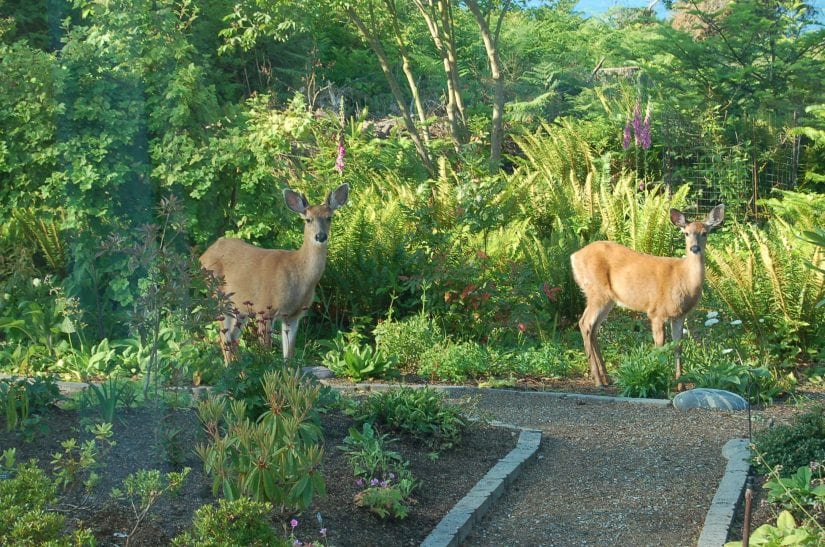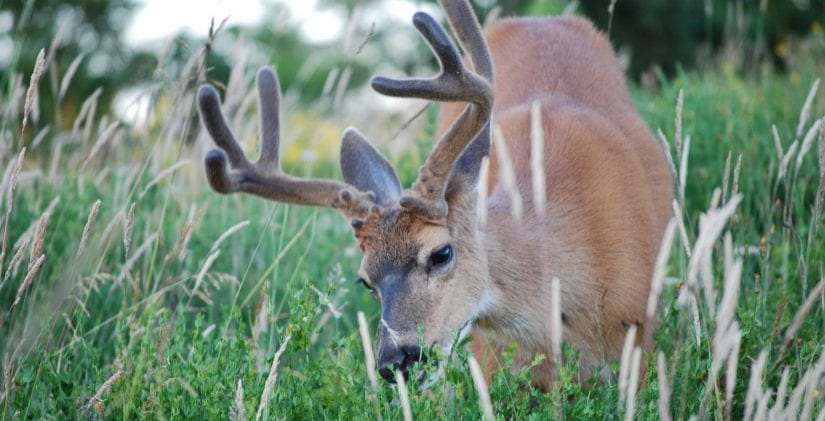Gardening in deer territory certainly has its challenges but with a little patience and strategic planning, you can have a deer friendly, beautiful garden. Below are three strategies to keep in mind when gardening with deer. Keep in mind that besides fencing out deer completely, no garden will ever be completely deer proof but using a combination of these strategies will help ensure that damage is kept to a bare minimum. Following these methods, you will be able enjoy your garden and the majestic deer in your neighbourhood.

1.) Choosing the right plants – hint: it’s all about the foliage!
Deer can be picky when it comes to eating plants that have strong smells or textures. Choosing plants that are distasteful to deer will encourage them to find their dinner elsewhere. Here are some categories of plants that are deer resistant:
- Plants with fuzzy or hairy leaves: Butterfly bush (Buddleia), Siberian Bugloss (Brunnera), Lamb’s Ear (Stachys), Flowering Tobacco (Nicotiana), Lady’s Mantle (Alchemilla), Japanese Spirea (Spiraea) and Poppies (Papaver).
- Plants with prickly foliage (Note: plants with thorns on the stems, like roses, are not a good deterrent – deer are able to avoid the thorns and munch on the tender leaves without any issue): Oregon Grape (Mahonia), Globe Thistle (Echinops), Bear’s Breeches or Sea Holly (Acanthus) and Cardoon (Cynara).
- Plants with a strong scent: Lavender (Lavendula), Rosemary (Rosmarinus), Jasmine (Jasminum), Clematis (Clematis), Juniper (Juniperus), Boxwood (Buxus), Hyssop (Agastache), Catmint (Nepeta), Mugworts (Artemisia), Sage (Salvia), and all kinds of herbs like thyme, mint, dill, and oregano.
- Plants with toxic foliage (Note: keep in mind some of these plants can be toxic to human and pets if consumed): Ferns (Tracheophyta/Polystichum), Bleeding Hearts (Dicentra), Daffodils (Narcissus), Hellebores (Helleborus), Spurges (Euphorbia) and Monkshood (Aconitum).
- Plants with leathery or fibrous foliage: Stonecrop (Sedum), Iris (Iris), Peony (Paeonia), Pachysandra (Pachysandra), and Elephant Ear (Colocasia).
- Ornamental Grasses: Blue Fescue (Festuca), Sedge (Carex), Fountain Grass (Pennisetum), Reed Grass (Calamagrostis) and Hair Grass (Deschampsia).
2.) Fencing
There are many options for using fencing to prevent deer from eating your favourite plants, from enclosing your entire garden to netting off individual plants. The following are some fencing options to consider:
- Building an eight to ten foot tall fence: This can be an expensive option and you can risk the feeling that you have fenced yourself in as opposed to keeping the deer out. Deer are able to jump quite high so fencing that is lower than eight feet may allow the deer to jump over the fence and into your garden. Deer also like to see where they are jumping so a privacy fence that cannot be seen through is better than one where they can see what is on the other side.
- Building a 45˚ angled fence: Deer don’t have great depth perception and cannot jump both high and far at the same time. Constructing a fence that is approximately 6 feet tall and at a 45˚ angle is a great option to keep out deer.
- Building a double fence: If you already have a lower fence (for example a four foot tall picket fence) you can add a second fence just a few feet apart. The second fence should be about four feet tall and can be made of inexpensive material such as chicken wire. Deer don’t like to feel trapped and they will avoid jumping both of these fences to avoid being caught between.
- Using ‘invisible’ deer netting: A less costly option is to erect an eight-foot tall fence of deer netting around your garden. Be sure to add flagging tape or streamers to the netting to prevent the deer from running into the fence and becoming entangled.
- Netting off individual plants: If the majority of your garden is deer proof but you have a few plants that the deer love to eat, use bird netting to keep those plants isolated from the deer.

3.) Deer repellants and deterrents
- Deer repellant products can be very effective in preventing deer from eating plants they normally love. These products (such as Bobex, Liquid Fence and Deer Away) work by using a combination of smell and taste deterrents with ingredients such as putrefied eggs, soaps and/or garlic. They can be quite smelly when first applied but the smell dissipates after it dries. In order for these products to be effective, you must be vigilant in the application and be sure to follow the directions.
- Motion activated sprinklers are a great way to frighten deer away from specific areas of your garden like a vegetable patch. When these sprinklers sense motion, they emit a sharp burst of water toward the movement making them very accurate and effective. Brands that utilize infrared sensors also work at night allowing for even more protection.
WildSense newsletter
Want to receive more stories like this, right in your inbox? Subscribe to WildSense, our bi-monthly wildlife newsletter.
The BC SPCA uses your personal information to update you on our work for animals as well as for advertising and analytics purposes. More information on uses and how to opt-out can be found in our Privacy Policy.

